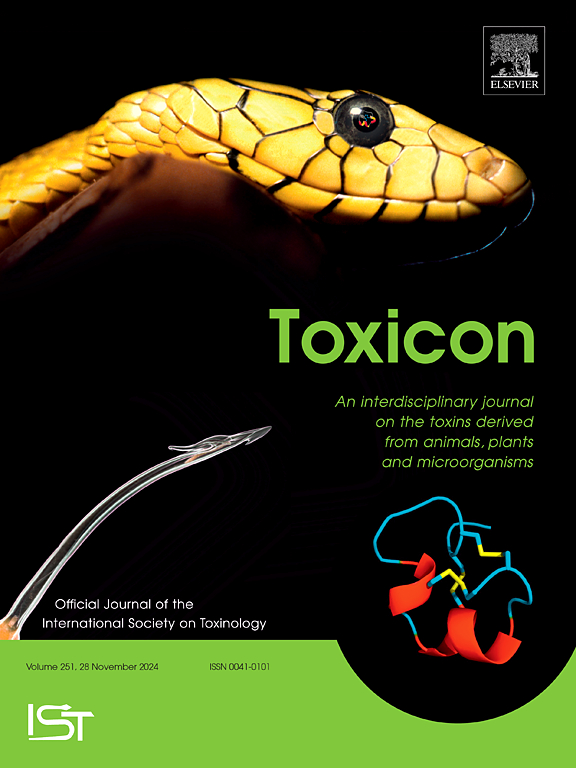The DHCR7 is the key target of lipotoxic liver injury caused by matrine through abnormal activation of the cholesterol synthesis pathway
IF 2.6
4区 医学
Q2 PHARMACOLOGY & PHARMACY
引用次数: 0
Abstract
Background
Matrine, the main active ingredient in Sophora flavescens and Sophorae tonkinensis radix et rhizome, is a highly effective insecticide. However, its hepatotoxicity to some extent affects its application value. This study aimed to explore the mechanism underlying matrine-induced liver injury.
Methods
The zebrafish (Danio rerio) and L02 cell model were utilized to investigate the toxic dose of matrine and its effects on liver tissue damage, liver cell morphology and activity, and expression levels of ALT and AST. Zebrafish and L02 cell samples were then collected for transcriptomic testing to further explore the possible mechanism by which matrine induced liver injury. Finally, integrated bioinformatics methods and experiments were used to elucidate the possible mechanisms behind matrine-induced liver injury.
Results
The result presented solid in vivo evidence of matrine-induced hepatotoxicity, supported by abnormal changes of liver morphological, disturbed liver cell structure, obvious apoptosis, as well as elevated levels of ALT and AST in zebrafish. In addition, in vitro L02 cell experiments also showed that matrine can produce significant liver cell damage effects. The integrated bioinformatics analysis results revealed that differentially expressed genes (DEGs) were substantially enriched in multiple pathways related to lipid regulation. Among which, the steroid biosynthesis was the most key signaling pathway, evidenced by the enhanced expression of eight genes, including DHCR7, SQLE, CYP51, CYP24A1, SC5D, LSS, MSMO1 and SOAT1. Furthermore, AY9944, the targeted inhibitor of DHCR7, could offset the toxic effect, as reflected by diminished liver phenotype damage, steatosis, and cholesterol accumulation caused by matrine.
Conclusions
Matrine can upregulate the expression of key genes in steroid biosynthesis pathway, resulting in cholesterol accumulation and then inducing hepatotoxicity. Among them, targeted inhibition of DHCR7 gene expression can alleviate matrine-induced liver injury.

DHCR7通过异常激活胆固醇合成途径,是苦参碱引起的脂毒性肝损伤的关键靶点
苦参碱是苦参和北参根茎中的主要活性成分,是一种高效的杀虫剂。但其肝毒性在一定程度上影响了其应用价值。本研究旨在探讨苦参碱性肝损伤的机制。方法采用斑马鱼(Danio rerio)和L02细胞模型,研究苦参碱的毒性剂量及其对肝组织损伤、肝细胞形态和活性、ALT和AST表达水平的影响,并收集斑马鱼和L02细胞样本进行转录组学检测,进一步探讨苦参碱诱导肝损伤的可能机制。最后,采用综合生物信息学方法和实验来阐明海洋碱性肝损伤的可能机制。结果斑马鱼肝脏形态异常,肝细胞结构紊乱,细胞凋亡明显,ALT和AST水平升高,均为苦参碱引起肝毒性的活体证据。此外,体外L02细胞实验也表明苦参碱能产生显著的肝细胞损伤作用。综合生物信息学分析结果显示,差异表达基因(DEGs)在与脂质调节相关的多种途径中大量富集。其中,类固醇生物合成是最关键的信号通路,DHCR7、SQLE、CYP51、CYP24A1、SC5D、LSS、MSMO1和SOAT1等8个基因的表达增强。此外,DHCR7的靶向抑制剂AY9944可以抵消毒性作用,这可以通过减轻苦参碱引起的肝脏表型损伤、脂肪变性和胆固醇积累来体现。结论苦参碱可上调类固醇生物合成途径关键基因的表达,导致胆固醇积累,进而引起肝毒性。其中,靶向抑制DHCR7基因表达可减轻苦参碱所致肝损伤。
本文章由计算机程序翻译,如有差异,请以英文原文为准。
求助全文
约1分钟内获得全文
求助全文
来源期刊

Toxicon
医学-毒理学
CiteScore
4.80
自引率
10.70%
发文量
358
审稿时长
68 days
期刊介绍:
Toxicon has an open access mirror Toxicon: X, sharing the same aims and scope, editorial team, submission system and rigorous peer review. An introductory offer Toxicon: X - full waiver of the Open Access fee.
Toxicon''s "aims and scope" are to publish:
-articles containing the results of original research on problems related to toxins derived from animals, plants and microorganisms
-papers on novel findings related to the chemical, pharmacological, toxicological, and immunological properties of natural toxins
-molecular biological studies of toxins and other genes from poisonous and venomous organisms that advance understanding of the role or function of toxins
-clinical observations on poisoning and envenoming where a new therapeutic principle has been proposed or a decidedly superior clinical result has been obtained.
-material on the use of toxins as tools in studying biological processes and material on subjects related to venom and antivenom problems.
-articles on the translational application of toxins, for example as drugs and insecticides
-epidemiological studies on envenoming or poisoning, so long as they highlight a previously unrecognised medical problem or provide insight into the prevention or medical treatment of envenoming or poisoning. Retrospective surveys of hospital records, especially those lacking species identification, will not be considered for publication. Properly designed prospective community-based surveys are strongly encouraged.
-articles describing well-known activities of venoms, such as antibacterial, anticancer, and analgesic activities of arachnid venoms, without any attempt to define the mechanism of action or purify the active component, will not be considered for publication in Toxicon.
-review articles on problems related to toxinology.
To encourage the exchange of ideas, sections of the journal may be devoted to Short Communications, Letters to the Editor and activities of the affiliated societies.
 求助内容:
求助内容: 应助结果提醒方式:
应助结果提醒方式:


